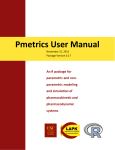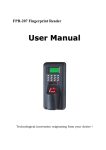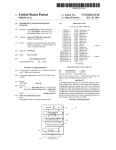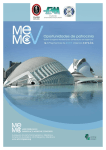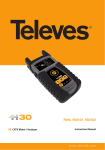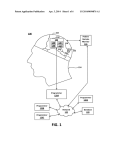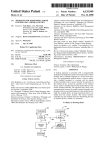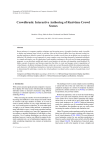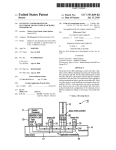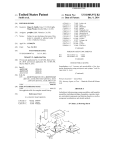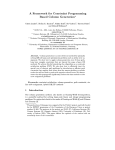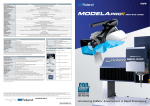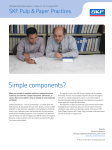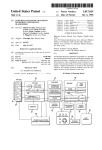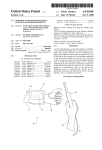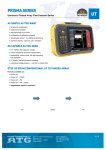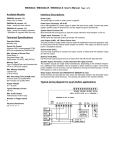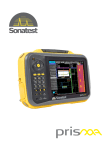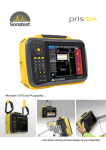Download Handheld ultrasound imaging systems
Transcript
US 20120232380A1 (19) United States (12) Patent Application Publication (10) Pub. No.: US 2012/0232380 A1 Pelissier et al. (54) (75) (60) HANDHELD ULTRASOUND IMAGING SYSTEMS Inventors: Provisional application No. 60/977,353, ?led on Oct. 3, 2007. Publication Classi?cation Laurent Pelissier, North Vancouver (CA); Kris Dickie, Vancouver (CA); KWun-Keat Chan, Vancouver (CA) (73) Assignee: Sep. 13, 2012 (43) Pub. Date: (51) Int. Cl. A61B 8/14 (52) ULTRASONIX MEDICAL (57) CORPORATION, Richmond (CA) (2006.01) US. Cl. ...................................................... .. 600/424 ABSTRACT A handheld ultrasound device is provided, having a trans (21) Appl. No.: 13/476,142 (22) Filed: May 21, 2012 ducer assembly for emitting and receiving sonic signals, a con?gurable signal processing unit, and a data processor con?gured to provide con?guration data to the signal pro cessing unit. The con?guration data de?nes a beamforming con?guration, ?ltering con?guration and envelope detection Related US. Application Data (63) con?guration for an operational mode. The operational mode Continuation of application No. 12/188,122, ?led on may be selected by the user or may be determined based on a Aug. 7, 2008. detected type of the transducer assembly. [10 12 I 14) / l/Os D/SPLA Y PROCESSOR, MEMORY and ‘7k 32 \ EMBEDDED OS 28 30f PFIEPROCESSING and ‘k DIGITAL BEAMFORMER FPGA 18 V’ 29 19 f I, 22 ,J’ RECEIVE VCAs and A/DS \L 24 TRANSMIT PULSERS L I 26 TRANSDUCER Patent Application Publication Sep. 13, 2012 Sheet 1 0f 8 US 2012/0232380 A1 I 10 12 I E J/ 14 DISPLAY l/Os I I \\ 32 i PROCESSOR, MEMORY and \ EMBEDDED 05 28 2”" k 15 30 PREPROCESSING and \L DIGITAL BEAMFORMER FPGA EJ 19 If RECEIVE VCAs and A/Ds \ k 22 ,J’ TRANS/WT PULSERS k F26 20 TRANSDUCER FIG. 1 18 ~ 29 L24 Patent Application Publication 10 Sep. 13, 2012 Sheet 2 0f 8 US 2012/0232380 A1 12 1 14 34 201 FIG.2A Patent Application Publication Sep. 13, 2012 Sheet 3 0f 8 US 2012/0232380 A1 14 34 20A FIG.2B Patent Application Publication Sep. 13, 2012 Sheet 4 0f 8 US 2012/0232380 A1 10\\. 14 34 20B FIG.2C Patent Application Publication Sep. 13, 2012 Sheet 5 0f 8 US 2012/0232380 A1 I40 42 ( TURN ON ) BOOT OS and EMBEDDED SOFTWARE I " 44 46 RECOGNIZE PL UGGED IN I ARRA Y 48 READ CONFIGURATION I DA TA FoR THE ARRAY i LOAD PREPROCESSING AND BEAIVIFORIVIING FPGA WITH THE CONFIGURATION DA TA l ( READY TO IMAGE FIG.3 ’ I 50 Patent Application Publication K Sep. 13, 2012 Sheet 6 0f 8 US 2012/0232380 A1 57 K 16 f 55 j J 585 - CONFIG DA TA PROCESSOR 58A - 58C — PATIENT DATA P 59 I 28 f I 16 30 I i 60 ,r'" TX BEAMFORMER PROGRAMMABLE PROCESSING UNIT 62 _/f/RX BEAMFORMER I FIG.4 18 Patent Application Publication DISPLAY Sep. 13, 2012 Sheet 7 of8 l/Os ‘\ 32 k 1 LINE PLACEMENT ~L SOFTWARE 16A L/NE PLACEMENT IMAGING SFOI IFNCF AND G! 11m: ~ k 18A i If, 24 RECEIVE VGA; and A/DS 22 -f TRANSM/T L Y 20 I TRANSDUCER FIG. 5A US 2012/0232380 A1 Patent Application Publication J’ 14 Sep. 13, 2012 Sheet 8 0f 8 DISPLAY 1/05 T i LABOR AND DEL/VERY 10 \ k 165 SOFTWARE i i LABOR AND DELIVERY ~ .QFOIIFNCF AND PRFRFT L RECEIVE VCAs and A/Ds ” 22 J' US 2012/0232380 A1 L 185 24 14 I TRANSM/T FIG. 6A FIG.6B Sep. 13, 2012 US 2012/0232380 A1 HANDHELD ULTRASOUND IMAGING SYSTEMS REFERENCE TO RELATED APPLICATIONS [0001] This application is a continuation of US. patent application Ser. No. 12/188,122 ?led 7 Aug. 2008, Which claims the bene?t under 35 U.S.C. §119 ofU.S. patent appli cation No. 60/977,353 ?led 3 Oct. 2007, all of Which are entitled HANDHELD ULTRASOUND IMAGING SYS TEMS and are hereby incorporated by reference. This appli [0008] Recent miniaturization of electronics has enabled the design of a generation of lighter, portable or handheld ultrasound systems. Ultrasound systems described in the patent literature include the folloWing US patents: [0009] US. Pat. No. 5,295,485 to Shinomura et al. describes a handheld ultrasound imaging system that can be adapted to support multi element array transduc ers and includes a beamformer. [0010] US. Pat. No. 5,722,412 to P?ugrath et al., US. Pat. No. 5,817,024 to Ogle et al., and US. Pat. No. cation claims the bene?t under 35 U.S.C. §120 of US. patent 6,203,498 to Bunce et al. describe handheld ultrasound application Ser. No. 12/188,122 ?led 7Aug. 2008 and entitled systems built around a set ofASIC (Application Speci?c Integrated Circuit) chips. The systems include a trans HANDHELD ULTRASOUND IMAGING SYSTEMS. ducer array, an ASIC transmit/receive front end, an TECHNICAL FIELD [0002] This invention relates to medical monitoring sys tems. The invention relates particularly to systems Which apply ultrasound to detect physiological features or charac teristics of a subject. Embodiments of the invention provide handheld ultrasound imaging devices. BACKGROUND [0003] Ultrasound imaging systems are used in medicine to explore internal areas of a subject’s body. Ultrasonic imaging is non-destructive and versatile and can provide high quality ASIC that includes digitiZation and digital beamforming capabilities, an ASIC for signal processing and an ASIC for display processing. [0011] US. Pat. Nos. 6,251,073 and 6,569,102 to Imran et al. describe a handheld ultrasound system that can construct an image built from multiple transmit/receive acquisitions that are temporarily stored in a memory. The handheld system has the ability to output a diagnos tic image built from multiple transmit/receive acquisi tions. [0012] US. Pat. Nos. 5,590,658, 6,106,472, and 6,638, diagnostic images. 226 to Chiang et al. describe a handheld ultrasound system that includes a transducer coupled to a CCD [0004] A typical medical ultrasound imaging system has a based analog beamformer and post processing electron transducer, a custom built electronic controller, and a user ics. The system uses a separate back-end to further pro interface. The transducer typically comprises an array of at least several regularly-spaced pieZoelectric transducer ele ments. The transducer elements may be arranged in any of several different geometries, depending upon the medical application for Which the transducer Will be used. [0005] The controller drives the transducer to emit ultra sound signals and collects and processes data from the trans ducer to provide, store, display and manipulate images. The user interfaces for typical ultrasound imaging systems typi cally include various input/ output devices Which alloW a user to control the operation of the imaging system. The input/ output devices typically comprise at least a control panel, a video display, and a printer. [0006] The electronic controller can send and receive elec tric signals to and from any of the transducer elements. To create a diagnostic image, the controller transmits electrical excitation signals to the transducer elements. The transducer elements convert the excitation signals into ultrasonic vibra tions, Which are transmitted into the subject’s body. The ultra sonic vibrations typically have frequencies in the range of about 2 MHZ to about 12 MHZ. The ultrasonic vibrations are scattered and re?ected by various structures in the subject’s body. Some of the re?ected and/ or scattered ultrasonic vibra tions, Which may be called echoes, are received at the trans ducer. The echoes cause the transducer elements to generate electrical signals. After the excitation signals have been trans mitted the controller receives and processes the electric sig nals from the transducer elements. [0007] The resulting image is displayed in real time on a display. The classic presentation of the display, called B-mode, is a tWo-dimensional image of a selected cross section of the patient’s body. Modern ultrasound systems also provide ?oW-imaging modes such as Color Doppler and Pulsed Doppler, Which shoW and can help to quantify blood ?oW. cess and display diagnostic images. [0013] US. Pat. No. 7,115,093 to Halmann et al. describes a handheld ultrasound imaging system com prising a detachable scanhead coupled to a traditional beamforming module, that is connected via a USB (Uni versal Serial Bus) port to a commercially available PDA (Portable Digital Assistant). The PDA performs post processing functions to yield ultrasound images. [0014] The inventors have recogniZed a need for a handheld ultrasound imaging device that is cost effective and can be con?gured to operate in multiple different modes to address different application-speci?c needs. BRIEF DESCRIPTION OF THE DRAWINGS [0015] Non-limiting example embodiments are illustrated in the accompanying draWings. The embodiments and ?gures disclosed herein are examples that illustrate Ways in Which the invention may be implemented. The invention is not lim ited to the illustrated embodiments. [0016] FIG. 1 is a block diagram illustrating major func tional components of a ultrasound imaging device according to an embodiment of the invention. [0017] FIGS. 2A, 2B and 2C illustrate an ultrasound imag ing device according to an example embodiment of the inven tion equipped With different transducer assemblies for use in different operational modes. In FIG. 2A the transducer assembly has elements arranged in a convex array. In FIG. 2B the transducer assembly has elements arranged in a linear array. In FIG. 2C the transducer assembly has elements arranged to provide a phased array. [0018] FIG. 3 is a How chart illustrating a method for ini tialiZing an imaging device according to an embodiment of the invention. Sep. 13,2012 US 2012/0232380 A1 [0019] FIG. 4 is a more detailed vieW illustrating features of a processor unit and a signal processing unit in an example embodiment. [0020] FIG. 5A is a block diagram illustrating an ultra [0031] sound imaging device con?gured for line placement and FIG. [0032] 5B is an example of an image that could be generated by the ultrasound imaging device of FIG. 5A. [0021] FIG. 6A is a block diagram of an ultrasound imaging device con?gured for monitoring labour and delivery in obstetrics applications and FIG. 6B is an example of an image of the type that could be produced by the ultrasound imaging HAND-HELD DEVICE ULTRASOUND IMAGING RECONFIGURABLE USER INTERFACE (claiming priority from application No. 60/955,328); POWER MANAGEMENT IN PORTABLE ULTRASOUND DEVICES (claiming priority from application No. 60/955,329); [0033] HAND-HELD ULTRASOUND IMAGING DEVICE HAVING REMOVABLE TRANSDUCER ARRAYS (claiming priority from application No. 60/955,325); and, [0034] device of FIG. 6A. HAVING WIRELESS NETWORK HAVING PORTABLE ULTRASOUND DEVICES (claiming priority from application No. 60/955,33 1) DESCRIPTION all of Which are hereby incorporated herein by reference. [0022] Throughout the folloWing description speci?c details are set forth in order to provide a more thorough understanding to persons skilled in the art. HoWever, Well knoWn elements may not have been shoWn or described in detail to avoid unnecessarily obscuring the disclosure. Accordingly, the description and draWings are to be regarded [0035] FIG. 1 shoWs an ultrasound imaging device 10 according to an example embodiment of the invention. Device 10 has a housing 12 containing electronic circuitry Which controls transducer elements in a transducer assembly 20 to transmit ultrasound signals into a subject. The electronic it to be carried in a shirt pocket. The device may provide a simpli?ed user interface for each operational mode so that it circuitry also receives ultrasound signals that have been re?ected from Within the subject and processes those ultra sound signals to yield an image. [0036] Device 10 comprises a display 14 upon Which an image may be displayed, a processor unit 16 Which may comprise a data processor, memory and associated operating system, and a con?gurable signal processing unit 18. Under the control of processor unit 16, signal processing unit 18 may can be used by personnel Who may not have extensive training be con?gured to provide signal processing appropriate to The different operational modes may be selected for use in different point of care settings, Where a practitioner is inter different operational modes. [0037] Some examples of different operational modes are ested in looking inside patients’ bodies for gathering anatomy information, monitoring vital functions, targeting a particular body structure, observing organ con?gurations, looking at modes tailored to: in an illustrative, rather than a restrictive, sense. [0023] An example embodiment of the invention provides a hand-holdable ultrasound imaging device that can be con?g ured to perform a range of speci?c ultrasound imaging pro cedures. The device preferably has a form-factor that permits [0038] fetal positions or the like. [0024] The features of the invention described herein may be combined in any suitable combinations With the features [0039] described in the commonly-oWned US provisional patent applications entitled: [0040] [0025] HAND-HELD ULTRASOUND SYSTEM HAV ING STERILE ENCLOSURE (application No. 60/955, 327); [0026] HAND-HELD DEVICE HAVING ULTRASOUND IMAGING RECONFIGURABLE USER INTERFACE (application No. 60/955,328); [0027] POWER MANAGEMENT IN PORTABLE ULTRASOUND DEVICES (application No. 60/ 955, 329); [0028] HAND-HELD ULTRASOUND IMAGING DEVICE HAVING REMOVABLE TRANSDUCER ARRAYS (application No. 60/955,325); and [0029] WIRELESS NETWORK HAVING PORTABLE ULTRASOUND DEVICES (application No. 60/ 955, 331) all of Which are hereby incorporated herein by reference. The features of the invention described herein may also be com bined in any suitable combinations With the features obtaining at least basic information about fetus position prior to and during delivery in labour and deliv ery rooms; monitoring a position of a needle in biopsy line placement and optionally providing a biopsy guide dis Play; screening for conditions such as Abdominal Aor tic Aneurysm; and, [0041] the like. [0042] Device 10 optionally includes a stored user manual and/or a stored audio and/or visual user guide that can be played to a user on device 10. The user manual and user guide may explain use of device 10 in the current operational mode. [0043] When device 10 is operating in an operational mode, processor unit 16 interacting With signal processing unit 18 generates control signals 19 Which cause transmit pulsers 22 to generate driving signals for transducer elements in trans ducer assembly 20. The driving signals are delivered to trans ducer assembly 20 by Way of interface 26. The timing, phases, intensities and/or other characteristics of the driving signals may be set to provide ultrasonic signals appropriate to the current operational mode. For example, the timing, phases, intensities and/or other characteristics of the driving signals delivered to transducer assembly 20 may be controlled by signal processing unit 18 (using control signals 19) Which described in the commonly-oWned US non-provisional may in turn be con?gured for the current operational mode by processing unit 16 (using appropriate control signals on data patent applications Which are ?led on the same day as the path 28). instant application and entitled: [0044] Transducer assembly 20 has elements Whichpick up HAND-HELD ULTRASOUND SYSTEM HAV re?ected ultrasound signals. These re?ected signals are ING STERILE ENCLOSURE (claiming priority from passed through interface 26 to receive signal conditioning stage 24. Signal conditioning stage 24 may include ?lters, [0030] application No. 60/955,327); Sep. 13,2012 US 2012/0232380 A1 voltage controlled ampli?ers, and the like to condition incom ing signals. Signal conditioning stage 24 also includes one or more analog to digital converters Which digitiZe the signals picked up by elements of transducer assembly 20 and pass the place ultrasound device 10 in data communication With one or more other devices. Input/output interface(s) 32 may com prise one or more Wireless interfaces (Which may, for digitiZed signals 29 to signal processing unit 18. [0045] Within signal processing unit 18, signals 29 are interfaces or the like) or other connections such as serial entirely or partially processed and then passed on data con nection 30 to processor unit 16 Which displays the resulting image on display 14 or, in the alternative, provides further processing of the signals on data path 30 (i.e. from signal processing unit 18) and then displays the resulting image on display 14. [0046] In some embodiments the signals passed to proces sor unit 16 by signal processing unit 18 (on data path 30) [0052] Input/output interface(s) 32 may be provided to example, comprise RF Wireless interfaces, infrared Wireless connections, USB connections, parallel connections, or the like. In some embodiments, device 10 has Wireless connec tivity according to the BluetoothTM standard or an IEEE 802. 11 standard (otherWise knoWn as WIFI). [0053] FIG. 2A shoWs a handheld ultrasound imaging device 10 according to an example embodiment of the inven tion. Device 10 has a housing 12 Which is suitably small comprise RF data (eg data provided at a rate that is tWo or more times the frequency of the ultrasound emitted by trans enough to be hand carried, and preferably is small enough to keep in a person’s pocket. For example, housing 12 may have ducer assembly 20). In such embodiments, processor unit 16 performs further processing to derive image data from the RF data. By Way of non-limiting example, processor unit 16 may perform functions such as: frequency analysis of the received signals (by Way of a fast Fourier transform (FFT) algorithm, dimensions of approximately 10 cm><8 cm><2 cm, and device for example); auto -correlation; and the like in addition to or as part of obtaining the image data. [0047] In modes Which involve Doppler imaging, signal processing unit 18 may be con?gured to perform digital Wall ?ltering and/or auto-correlation. [0048] As is apparent from the above, some functions that are required in the signal path for certain operational modes may be performed either by processor unit 16 or by signal processing unit 18. In some cases, performance may be increased by performing functions such as ?ltering, envelope detection, log compression, auto-correlation in processor unit 16. This may permit additional functions to be provided in signal processing unit 18 in those cases Where the capacity of signal processing unit 18 is limited. [0049] In some embodiments, signal processing unit 18 is con?gured to perform beamforming on at least the signals received from transducer assembly 20. In some embodi ments, in addition to beamforming, signal processing unit 18 performs ?ltering and/or envelope detection on the signals received from transducer assembly 20. [0050] In those embodiments Where signal processing unit 18 performs ?ltering of the signals received from transducer assembly 20, signal processing unit 18 may be con?gurable to implement digital ?lters having different ?lter coef?cients for different applications. The ?lter coef?cients may be selected to provide a good signal-to-noise ratio for each speci?c appli cation (e.g. each speci?c operational mode). For example, the ?lter coef?cients may be selected to pass signals having fre 10 may Weigh less than 10 pounds (i.e. 4.5 kg). A display 14 is provided on housing 12 as are one or more user interface controls 34. Control 34 may, for example, comprise an on/off sWitch for the purpose of turning device 10 on and shutting device 10 off. [0054] In some embodiments, display 14 comprises a touch-sensitive display and controls for operating device 10 may be provided in the form of touch-sensitive areas on display 14 and/or by Way of the capability of device 10 to recogniZe gestures or other patterns of contact betWeen a user’s ?nger, or a stylus and display 14. [0055] A bene?t of the architecture described herein is that it permits the same hardWare to be con?gured in different manners (e. g. different operational modes) so as to provide different specialiZed imaging functions. For example, ultra sound device 10 may be con?gured to provide imaging suit able for use in monitoring a fetus prior to and during labour and delivery. The same device 10 may be con?gured differ ently to provide imaging that is optimiZed for guiding a needle, such as a needle for taking a biopsy or some other type of needle into a tissue or other physiological structure of interest. Other operational modes may be provided for some other speci?c purposes. [0056] Each operational mode may have associated With it a number of different elements. These may include, for example: [0057] speci?c con?gurations of signal processing unit 18 and/ or transmit pulsers 22 to generate speci?c ultra sound signals and to process resulting re?ected signals detected at transducer assembly 20 in such a Way as to provide ultrasound images appropriate to the opera tional mode; quencies in a band around a frequency at Which elements of transducer assembly 20 are driven to emit ultrasound. Recon [0058] ?guring signal processing unit 18 may comprise program ming interconnects (e.g. signal connections) Within a section of a ?eld-programmable gate array (FPGA) that implements [0059] various help functions provided by device 10 one or more digital ?lters for the received signals. [0051] In those embodiments Where signal processing unit 18 performs envelope detection on the signals received from transducer assembly 20, signal processing unit 18 may be con?gurable to select from among a plurality of different envelope detection algorithms. Recon?guring signal process ing unit 18 may comprise programming interconnects (e.g. signal connections) Within a section of an FPGA that imple ments one or more envelope detectors that act on the received signals. user interface controls Which are speci?c to the operational mode; Which are speci?c to the operational mode to assist users in properly using device 10 in the operational mode. [0060] The ability to con?gure a single hardWare platform to provide a range of specialiZed operational modes permits volume manufacture of the platform even in cases Where some of the individual operational modes may be very spe cialiZed and in relatively loW demand. Furthermore, the abil ity to specialiZe the device under softWare control by adding and/or removing and/or repositioning and/or recon?guring user interface controls on display 14 and/or by changing functions assigned to any interface controls not provided by Sep. 13,2012 US 2012/0232380 A1 display 14 permits the device 10 to offer a simpli?ed and highly effective user interface in each of its available special iZed operational modes. [0061] In some embodiments, a device 10 can be locked in a selected operational mode. Such a device may be sold at a relatively loW cost Without disrupting the market for devices 10 con?gured to perform in other operational modes. the device is turned on. In block 44, device 10 initialiZes itself by starting to run its operating system and then invoking embedded softWare Which coordinates the overall operation of device 10 (eg on a processor of processor unit 16). In block 46, the type of transducer assembly 20 that is connected to device 10 is determined (either by detecting information identifying the transducer assembly 20 or in some embodi the same date as the instant application) both of Which are ments by receiving user input). [0068] In block 48, the con?guration data for the opera tional mode corresponding to the transducer assembly 20 recognized in block 46 is read and, in the illustrated embodi ment, signal processing unit 18 is con?gured according to the con?guration data in block 50. The con?guration data may hereby incorporated herein by reference. additionally specify softWare to be run on processor unit 16 to [0063] support imaging in the corresponding operational mode. In block 50, the transmit and receive circuitry (i.e. transmit pulsers 22 and receive signal processing stage 24) may be shut doWn and placed in a standby mode Waiting for instruc [0062] The user interface may be provided as described in co-pending US. Patent Application No. 60/955,328 entitled Hand-held Ultrasound Imaging Device Having Recon?g urable User Interface (?led on 10 Aug. 2007) or its counter part US non-provisional application of the same title (?led on In some cases for different operational modes it is desirable to provide different arrangements of transducer ele ments in transducer assembly 20. For this purpose, device 10 may be con?gured to permit the use of interchangeable trans ducer assemblies 20 that may be removed and replaced With different transducer assemblies suitable for different opera tional modes. For example, device 10 may be con?gured as described in US. Patent Application No. 60/955,325 entitled tions to commence imaging. [0069] Although not speci?cally shoWn in FIG. 3, user interface controls and/ or user manual information associated With the operational mode may also be loaded by processor Hand-held Ultrasound Imaging Device Having Removable Transducer Arrays (?led on 10 Aug. 2007) or its counterpart unit 16 as a part of method 40 or otherwise. US non-provisional application of the same title (?led on the same date as the instant application) both of Which are hereby 10 detecting that transducer assembly 20 is in contact With a subject or, in the alternative, may be invoked by means of a incorporated herein by reference. suitable user interface control. [0064] In such cases, device 10 may be con?gured so that it [0070] [0071] Imaging may commence automatically upon device FIG. 4 shoWs, in more detail, processor unit 16 and automatically switches betWeen operational modes in signal processing unit 18 according to a particular embodi response to detecting that a transducer assembly 20 has been changed to a different type of transducer assembly. In the alternative, device 10 can perform a routine to detect the type of connected transducer assembly 20, either on initialization processor(s) 55ia single data processor 55 is shoWn in the illustrated embodiment. Data processor 55 may, for example, or at some other time and can select an appropriate opera tional mode based upon information identifying the type of transducer assembly 20 identi?ed in the initialiZation routine. [0065] FIGS. 2A, 2B and 2C shoW, for example, a device 10 to Which different transducer assemblies 20, 20A and 20B have been attached respectively. A different operational mode may correspond to each of transducer assemblies 20, 20A and 20B. Device 10 may be sWitched betWeen these operational modes by selecting and installing the corresponding trans ducer assembly. ment. Processor unit 16 comprises one or more suitable data comprise a suitable microprocessor, digital signal processor (DSP), image processor, or the like. In an example embodi ment, data processor 55 comprises a BlackFinTM digital sig nal processor available from Analog Devices, Inc. of Nor Wood Mass. [0072] Processor 55 is capable of executing softWare instructions Which may be stored in memory 57 accessible to processor 55 or Which may be otherWise accessible to pro cessor 55. In the illustrated embodiment, memory 57 contains an operating system 58A and con?guration data 58B for one or more operational modes. Memory 57 may also have capac [0066] In other embodiments, a device 10 may be sWitched betWeen operational modes by means of a control provided on a user interface. In still other embodiments, device 10 is ity to store patient data 58C (e. g. images, information identi fying patients, or the like). intended to offer a single speci?c operational mode. Device particular operational mode and/or for a particular type of transducer array 20) to be delivered to signal processing unit 10 may be upgraded to provide enhanced features or to Work according to some different operational mode by uploading neW con?guration data to device 10 by Way of input/output interface(s) 32. In some embodiments, device 10 stores con ?guration data on a removable medium such as a card, chip, memory stick, memory or the like. In such embodiments it may be possible to upgrade an existing operational mode or add or change to a neW operational mode by replacing the removable medium With a removable medium that has con ?guration data for the neW or upgraded operational mode. In some embodiments, device 10 may have con?guration data for a number of different operational modes but some of the operational modes may be locked out until a passWord, digital key, or other authoriZation code is provided to release the functionality of some of the operational modes. [0067] FIG. 3 shoWs a method 40 that may be implemented When a device 10 as described above is turned on. In block 42 [0073] Processor 55 can cause con?guration data (eg for a 18 by data path 28 or directly from a memory 57 to signal processing unit 18 by Way of a suitable bus (e.g. bus 59) connected to deliver the con?guration data from memory 57 to signal processing unit 18. Such con?guration data may comprise all or a part of con?guration data 58B stored in memory 57. The con?guration data may cause suitable inter connects (e.g. signal processing paths) to be created Within signal processing unit 18 for the purpose of generating suit able transmitted ultrasound signals and processing received ultrasound signals in such a manner as to produce an image appropriate for the current operational mode. [0074] In the embodiment illustrated in FIG. 4, signal pro cessing unit 18 is con?gured by con?guration data delivered by Way of data path 28 to provide a transmit beamformer 60 and a receive beamformer 62. Depending upon the opera tional mode, transmit beamformer 60 and receive beam Sep. 13,2012 US 2012/0232380 A1 former 62 may comprise different numbers of channels and may be con?gured in different Ways to provide different characteristics of the transmitted ultrasound signal as Well as to derive different information from received ultrasound sig nals. [0075] Processor unit 16 may be con?gured to synchronize features of the operational mode. The resulting coef?cients may then be saved into memory 57 so that they are available to be loaded for con?guration of signal processing unit 18 When the user-de?ned operational mode is invoked. [0085] FIG. 5A shoWs an example of a device 10 Which has been con?gured to provide a line placement operational mode the transmission and reception of ultrasound signals by trans ducer assembly 20. In such embodiments, synchronization signals may be provided by Way of data path 28. [0076] When a received ultrasound signal is passed to sig and FIG. 5B shoWs an example of a resulting image 66 When device 10 is so con?gured. In the illustrated embodiment, line placement softWare executes on processor unit 16A and sig nal processing unit 18, the received signal is processed by provide line placement imaging sequence and guide func tions. In this operational mode, signal processing unit 18A Way of receive beamformer 62 and the resulting data is passed to processor unit 16 by Way of data connection 30. Processor 55 processes the data that it receives in a manner speci?ed by the con?guration data 58B associated With the current opera tional mode and displays the resulting data on display 14 in the form of a suitable display. Processor 55 may optionally also store the image data in memory 57 and/or transmit the image data to a netWork or other device by Way of input/ nal processing unit 18A is con?gured in such a manner as to may be con?gured With beamforming coef?cients that result in enhanced visibility in an image 66 of a needle 66B or the like (FIG. 5B) being inserted into a subject. [0086] FIG. 5B shoWs an example of an image 66 Which could be provided on display 14 during operation of device 10 When it is in the line placement operational mode of FIG. 5A. Image 66 includes depictions 66A of various anatomical output interface(s) 32. structures in the subject, an image of a needle or probe 66B, [0077] In some embodiments, signal processing unit 18 comprises a ?eld programmable gate array (FPGA) that is and generated guide lines 66C Which indicate a desired place ment of the needle or probe. Parameters used to generate connected to a memory 57 by a bus 59. Memory 57 may store guidelines 66C may be speci?ed in con?guration data and/or con?guration data 58B. Such con?guration data 58B may in softWare executing on processor unit 16. [0087] FIG. 6A illustrate a device 10 con?gured to operate in a labour and delivery operational mode Which is intended for monitoring the labour or pregnant Women and the delivery of babies in obstetric applications and FIG. 6B shoWs an comprise con?guration data associated With one or more operational modes. By Way of non-limiting example, the con?guration data associated With each operational mode may comprise information specifying one or more of: [0078] [0079] [0080] [0081] transmit beamforming parameters; receive beamforming parameters; ?ltering parameters; envelope detection parameters; [0082] etc. All con?guration data 58B may be stored in memory 57. Memory 57 may, for example, comprise a ?ash memory or the like. Providing a single memory 57 that contains all con example of a resulting image 68 Which may be provided on display 14 When device 10 is so con?gured. In this embodi ment, processor unit 16B is con?gured to execute labour and delivery softWare and signal processing unit 18B is con?g ured to generate ultrasound signals and process detected ultrasound signals in Ways suitable for providing good quality images of a fetus in utero and/or in the birth canal. [0088] A device 10 may usefully include features as ?guration data 58B simpli?es construction and potentially described in co-pending U.S. Application No. 60/955,329 reduces poWer consumption. Processor unit 16 may control, directly or indirectly, What portion of con?guration data 58B is loaded from memory 57 into signal processing unit 18. The portion of con?guration data 58B loaded into signal process ing unit 18 may be associated With a particular operational mode. entitled PoWer Management in Portable Ultrasound Devices (?led on 10 Aug. 2007) or its counterpart US non-provisional [0083] Some embodiments provide the option of con?gur application of the same title (?led on the same date as the instant application) both of Which are hereby incorporated herein by reference. These applications describe the use of con?guration data to place an ultrasound device in different operational modes as Well as to use con?guration data to place ing signal processing unit 18 differently for each line of an ultrasound image. In some such embodiments, con?guration data for all lines of the ultrasound image may be stored in the ultrasound device in various poWer consumption modes. memory 57 and retrieved by Way of bus 59 (or data connec tion 28) on an as-needed basis. For example, signal process ing unit 18 may comprise a buffer that holds con?guration data for a current ultrasound image line and also has space to con?gured to both generate control signals for transmit pulsers 22 and to provide processing of detected signals received from elements of transducer assembly 20. Providing receive con?guration data for one or more subsequent ultra because it reduces the Width of the signal path required betWeen processor unit 16 and signal processing unit 18. [0090] Example embodiments of the invention may be sound image lines. The con?guration data for the subsequent ultrasound image lines may be read into the buffer from memory 57 While the current ultrasound image line is being processed according to con?guration data in the buffer. To facilitate such operation, the buffer may be set up as a circular buffer or ‘ping-pong’ buffer, for example. [0084] Some or all of the con?guration data 58B stored in memory 57 may be generated by processor 55 executing suitable softWare instructions. For example, processor 55 may execute softWare for calculating ?ltering coef?cients and/ or beamforming coef?cients for a particular operational mode. User controls may be provided so that a user can de?ne [0089] As discussed above, signal processing unit 18 may comprise an FPGA. Advantageously, the same FPGA may be both of these functions in a single FPGA is advantageous made from readily-available off the shelf components as con trasted With custom circuitry such as complicated application speci?c integrated circuits (ASICS) Which are required to provide specialiZed functions in other devices. [0091] Where a component (e. g. a processor, circuit, beam former, signal conditioner, ?lter, control, assembly, device, circuit, etc.) is referred to above, unless otherWise indicated, reference to that component (including a reference to a “means”) should be interpreted as including as equivalents of that component any component Which performs the function Sep. 13,2012 US 2012/0232380 A1 of the described component (i.e., that is functionally equiva lent), including components Which are not structurally equivalent to the disclosed structure Which performs the func tion in the illustrated exemplary embodiments of the inven tion. The embodiments described above and depicted in the Figures are examples only. Features of those embodiments may be combined in Ways other than those expressly set out herein. [0092] While a number of exemplary aspects and embodi ments have been discussed above, those of skill in the art Will recognize certain modi?cations, permutations, additions and sub-combinations thereof. It is therefore intended that the folloWing appended claims and claims hereafter introduced are interpreted to include all such modi?cations, permuta ure the signal processing unit to implement digital ?lters having different ?lter coe?icients to provide ?ltering of the conditioned re?ected ultrasound signals received from the transducer assembly; the set of con?guration data for at least one of the opera tional modes is con?gured to con?gure the ?eld pro grammable gate array to both generate control signals for the transmit circuit and to provide processing of detected signals received from elements of the trans ducer assembly; the set of con?guration data for at least one of the opera tional modes is con?gured to specify softWare to be run on the processor unit to support imaging in the corre tions, additions and sub-combinations as are Within their true sponding operational mode, the softWare con?gured to spirit and scope. cause the processor unit to perform one or more of: What is claimed is: 1. A hand-holdable ultrasound system comprising: a detachable transducer assembly comprising a plurality of transducer elements, the transducer assembly inter changeable With one or more other transducer assem blies, the transducer assembly suitable for ultrasound imaging in a corresponding one of a plurality of opera tional modes of the ultrasound system; a driving circuit operable to deliver driving signals to excite the transducer elements of the transducer assembly to emit ultrasound signals, the driving circuit comprising a plurality of transmit pulsers; a receive circuit operable to receive re?ected ultrasound signals detected at the transducer assembly and to con dition the received re?ected ultrasound signals to yield conditioned signals, the receive circuit comprising one or more analog to digital converters arranged to digitiZe the received re?ected ultrasound signals; a con?gurable signal processing unit connected to receive the digitiZed conditioned signals and to process the con ditioned signals, the con?gurable signal processing unit comprising a ?eld programmable gate array; a processor unit comprising one or more data processors and a memory, the memory storing softWare instructions for execution by the one or more processors and a plu rality of sets of con?guration data, each of the plurality of sets of con?guration data corresponding to a corre sponding one of the operational modes of the plurality of operational modes; a display operable to display an image based at least in part on the re?ected ultrasound signals detected at the trans ducer assembly; and one or more user interface controls for providing user input to the hand-holdable ultrasound system; Wherein the softWare instructions are con?gured to cause the one or more data processors to: identify a type of the transducer assembly; based on the identi?ed type of the transducer assembly, select one of the plurality of operational modes cor responding to the transducer assembly for Which the ultrasound system should be con?gured; and con?gure each of: the signal processing unit, the trans mit circuit, the processor and the user interface con trols according to one of the sets of con?guration data ?ltering, envelope detection, log compression, and auto correlation; the set of con?guration data for at least one of the opera tional modes is con?gured to con?gure the signal pro cessor unit to pass RF data to the processor unit at a rate that is tWo or more times a frequency of the ultrasound signals and to con?gure the processor unit to perform further processing to derive image data from the RF data by one or more of: fast Fourier transform of the RF data and auto-correlation; the set of con?guration data for at least one of the opera tional modes is con?gured to con?gure the signal pro cessor unit to provide a transmit beamformer and a receive beamformer, the transmit beamformer and receive beamformer having different numbers of chan nels; the plurality of operational modes comprises a line place ment operational mode, one of the sets of con?guration data comprises line placement con?guration data, and the ultrasound system is con?gured according to the line placement con?guration data to provide imaging that is optimiZed for guiding a needle into a tissue or another physiological structure, the line placement con?gura tion data specifying line placement softWare to be executed by the processor unit and con?gured to con?g ure the signal processing unit With beamforming coe?i cients to provide enhanced visibility of a needle in an image, one or both of the line placement con?guration data and the line placement softWare comprising param eters for generating guidelines on the display to indicate a desired placement of a needle. 2. The hand-holdable ultrasound system according to claim 1 Wherein the hand-holdable ultrasound system Weighs less than 10 pounds and has transverse and longitudinal dimen sions less than about 15 centimetres and a Width less than about 5 centimetres. 3. The hand-holdable ultrasound system according to claim 1 Wherein each of the sets of con?guration data provides: a speci?c con?guration of the signal processing unit and the transmit pulsers to generate speci?c ultrasound sig nals and to process resulting re?ected signals detected at the transducer assembly to provide ultrasound images appropriate to the corresponding operational mode; corresponding to the selected operational mode; user interface controls Which are speci?c to the corre Wherein: the sets of con?guration data for different ones of the sponding operational mode; and help functions speci?c to the corresponding operational plurality of operational modes are con?gured to con?g mode to assist users in properly using the ultrasound Sep. 13, 2012 US 2012/0232380 A1 system in the corresponding operational mode, the help processing unit to provide a buffer that holds con?guration functions comprising images and videos for display on data for a current ultrasound image line Wherein the buffer the display. also has space to hold con?guration data for one or more 4. The hand-holdable ultrasound system according to claim 1 Wherein the ultrasound system comprises a set of transducer assemblies and the detachable transducer assembly is one of the set of transducer assemblies, the set of transducer assem blies comprising a ?rst transducer assembly comprising a convex array of transducer elements, a second transducer assembly comprising a linear array of transducer elements and a third transducer assembly comprising a phased array of transducer elements. 5. The hand-holdable ultrasound system according to claim 1 comprising one or more input/output interfaces for receiv ing the con?guration data into the hand-holdable ultrasound system Wherein the one or more input/output interfaces com prise at least one of: an interface to a removable memory medium; a Wireless communication interface; a serial data interface; a parallel data interface; and a universal serial bus interface. 6. The hand-holdable ultrasound system according to claim 1 Wherein the memory comprises a removable memory medium and the con?guration data is stored on the removable memory medium. 7. The hand-holdable ultrasound system according to claim 1 Wherein, for each of the plurality of operational modes the one or more user interface controls comprise a user interface control con?gured for providing a help request to the hand holdable ultrasound system and Wherein the processor unit is con?gured to respond to the help request in a manner Which is speci?c to a current one of the plurality of operational modes. 8. The hand-holdable ultrasound system according to claim 1 Wherein the display comprises one or more touch-sensitive user interface controls for providing user input to the hand holdable ultrasound system and the processor unit is con?g ured to add, remove, reposition and recon?gure the user inter face controls on the display under softWare control on sWitching among the operational modes. 9. The hand-holdable ultrasound system according to claim 1 Wherein, for at least a ?rst one of the plurality of operational modes, the processor unit is con?gured to provide con?gura tion data to the signal processing unit to con?gure the signal processing unit to provide different signal processing opera tions for different lines of an ultrasound image. 10. The hand-holdable ultrasound system according to claim 9 Wherein for the ?rst one of the operational modes con?guration data for all lines of an ultrasound image is stored in the memory and the signal processing unit is con ?gured to retrieve the con?guration data for the lines of the ultrasound image on an as-needed basis. 11. The hand-holdable ultrasound system according to subsequent ultrasound image lines. 12. The hand-holdable ultrasound system according to claim 11 Wherein the set of con?guration data for the ?rst one of the operational modes is con?gured to con?gure the signal processing unit to read con?guration data for subsequent ultrasound image lines into the buffer from the memory While a current ultrasound image line is being processed according to the con?guration data for the current ultrasound image line that is in the buffer. 13. The hand-holdable ultrasound system according to claim 11 Wherein the buffer comprises a circular buffer. 14. The hand-holdable ultrasound system according to claim 1 Wherein for each of the plurality of operational modes, timing, phases, and intensities of the driving signals delivered to the transducer assembly are controlled by the signal processing unit Which has been con?gured for the current operational mode by the processor unit. 15. The hand-holdable ultrasound system according to claim 1 Wherein for at least one of the operational modes the signal processing unit is con?gured to perform envelope detection on the signals received from the transducer assem bly. 16. The hand-holdable ultrasound system according to claim 15 Wherein the signal processing unit is con?gurable to provide an envelope detection algorithm from among a plu rality of different envelope detection algorithms by program ming interconnects Within a section of the ?eld program mable gate array that implements one or more envelope detectors arranged to act on the received signals. 17. The hand-holdable ultrasound system according to claim 1 Wherein the ultrasound system is locked in a selected one of the plurality of operational modes. 18. The hand-holdable ultrasound system according to claim 1 Wherein the processor unit is con?gured to synchro niZe the transmission and reception of ultrasound signals by the transducer assembly by generating synchronization sig nals and providing the synchronization signals to the signal processing unit. 19. The hand-holdable ultrasound system according to claim 1 Wherein the con?guration data associated With each of the plurality of operational modes comprises information specifying: transmit beamforming parameters; receive beam forming parameters; ?ltering parameters; and envelope detection parameters. 20. The hand-holdable ultrasound system according to claim 1 Wherein the plurality of operational modes includes a user-de?ned operational mode and the user interface controls comprise user controls con?gured to permit a user to de?ne features of the user-de?ned operational mode. claim 10 Wherein the set of con?guration data for the ?rst one of the operational modes is con?gured to con?gure the signal * * * * *
















